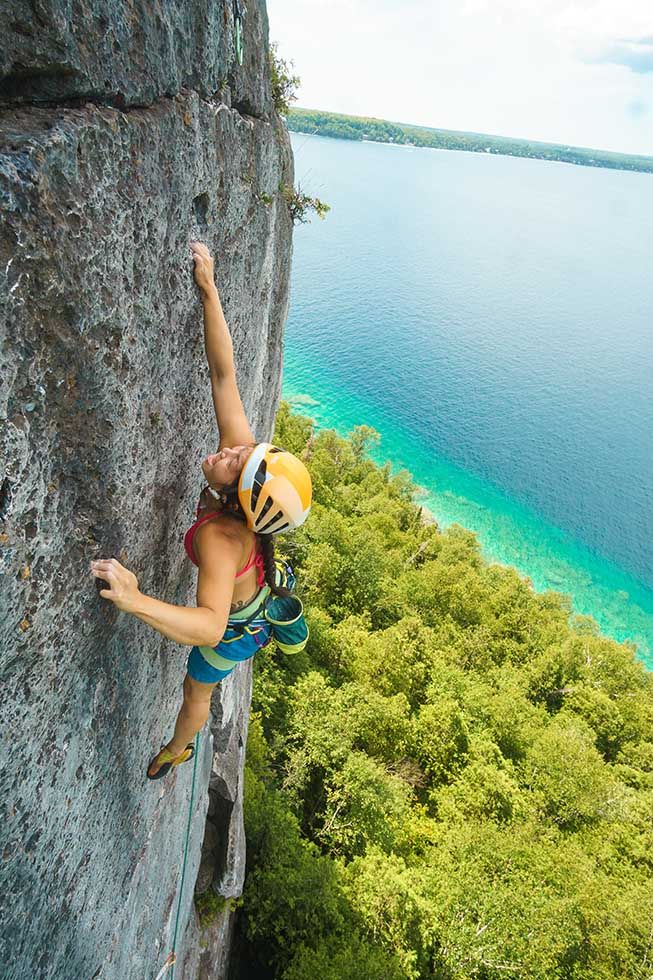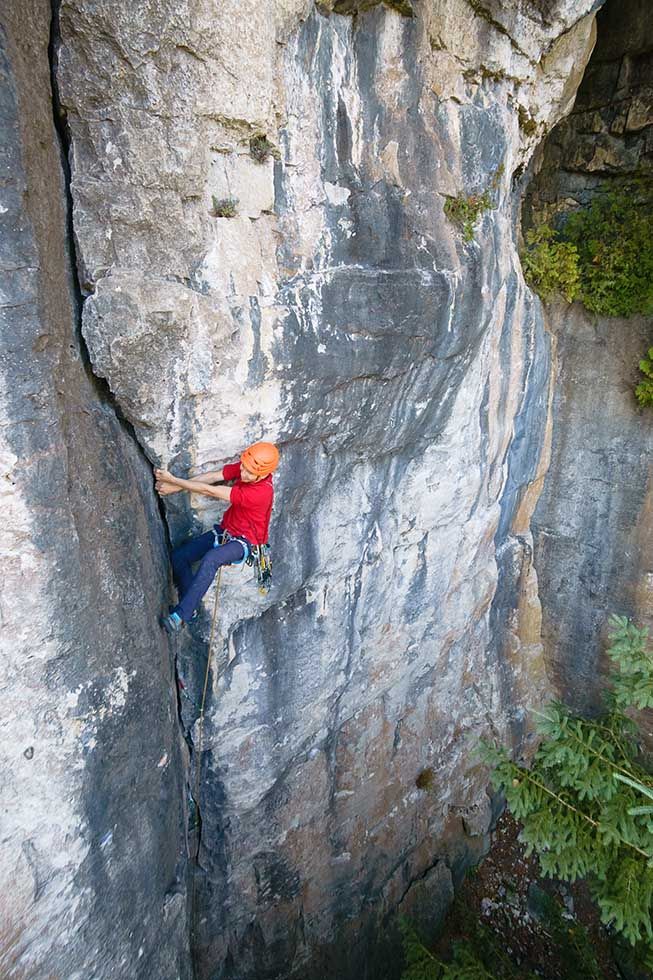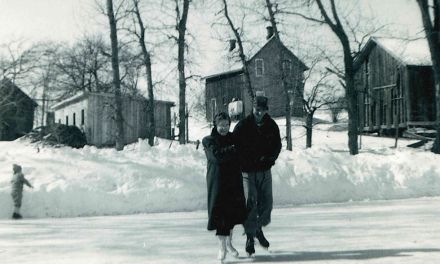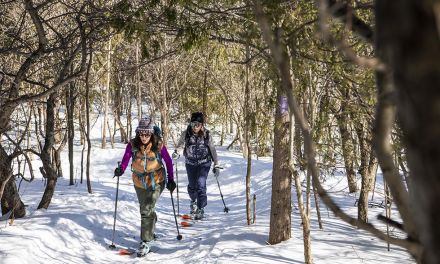Cliffs, Crags & Carabiners
Words & Photos by Will Tam
You may not know it, but Southern Ontario is a world-class rock climbing destination. During the summer months, hundreds of rock climbers travel to the many limestone cliffs (called “crags”) along the Niagara Escarpment to enjoy nature as well as the challenges that technical rock climbing affords. With the increase of climbing gyms and the sport’s inclusion in the 2020 Summer Olympic Games, climbing has seen a growth in popularity. The history of climbing in Southern Ontario is both rich and storied, producing world class talent from professional athletes to filmmakers and storytellers. Interestingly, some of our local crags have documented climbs dating back to the 1960s. By simply looking at the beauty of some of these rocks, we can easily see why climbers from around the world have come to climb on the Escarpment.
The influx of climbers brings tourism dollars to the small towns that neighbour the climbing crags. Dinning in, shopping at small businesses or even staying the night are all ways in which climbers support the local economy. Most climbers are also passionate about the outdoors and the natural environment, practicing leave-no-trace and organizing annual clean-ups. In Ontario, volunteer organizations like the Ontario Alliance of Climbers (OAC) provide resources for climbers and land managers on keeping access to climbing crags open and provide a community for climbers in the province. If you live near or enjoy the spaces around the Niagara Escarpment there are many wonderful crags to discover and experience; some of which are highlighted below. Take this summer to explore the vertical world of rock climbing—you might get hooked!
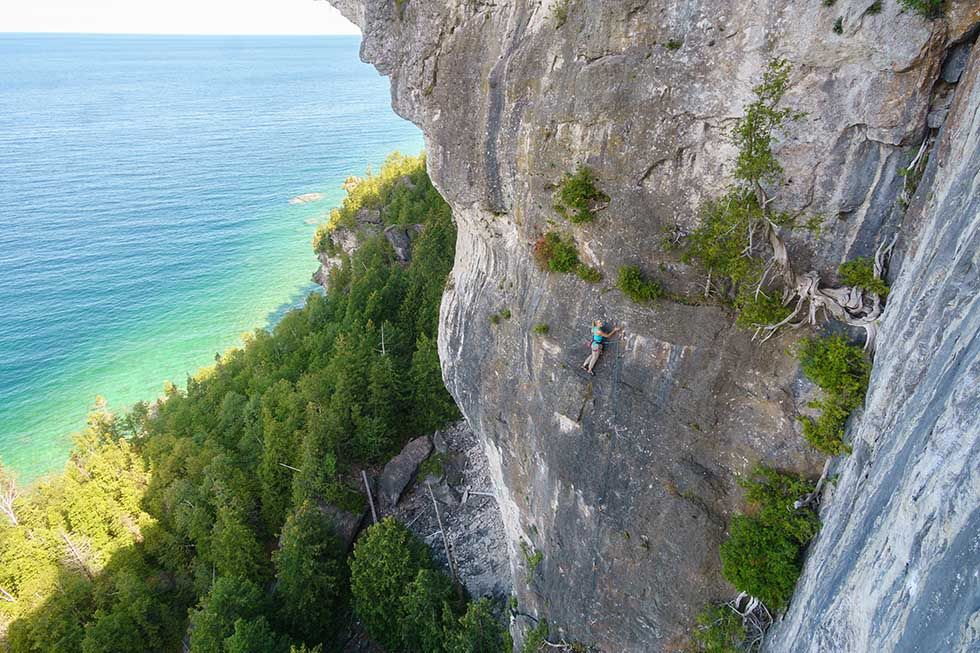

Lion’s Head, Northern Bruce Peninsula
The crown jewel of Southern Ontario climbing is at Lion’s Head, just north of Wiarton. The Escarpment cliffs rise over the cold, turquoise waters of Georgian Bay, which provides relief for climbers on hot summer days. The beauty of Lion’s Head is matched by the high-quality climbing routes found at this crag. Lion’s Head has the highest concentration of difficult climbing routes in the province and is home to the hardest climbing route: Forever Expired. On the other hand, climbers of moderate abilities can find adventure here as well from exposed routes like Wave Guiding and Nimbus, which climbs the namesake “Lion’s Head” at the lookout point. The climbing style at Lion’s Head is predominantly characterized by pocketed white limestone and technical slab climbing on the darker coloured rock. Lion’s Head has cultivated multiple climbing talents, and attracted professionals from abroad, including famous British climbers during the ‘90s, to professional American climbers in more recent years. Although the fastest way to access the crag is by boat, climbers can take the hiking trail from town. After a day of climbing, the village of Lion’s Head offers some delicious food options like the Lion’s Head Inn Restaurant & Pub and various diners along Main Street. Don’t forget to treat yourself to some ice cream and cool off in the water at the beach!

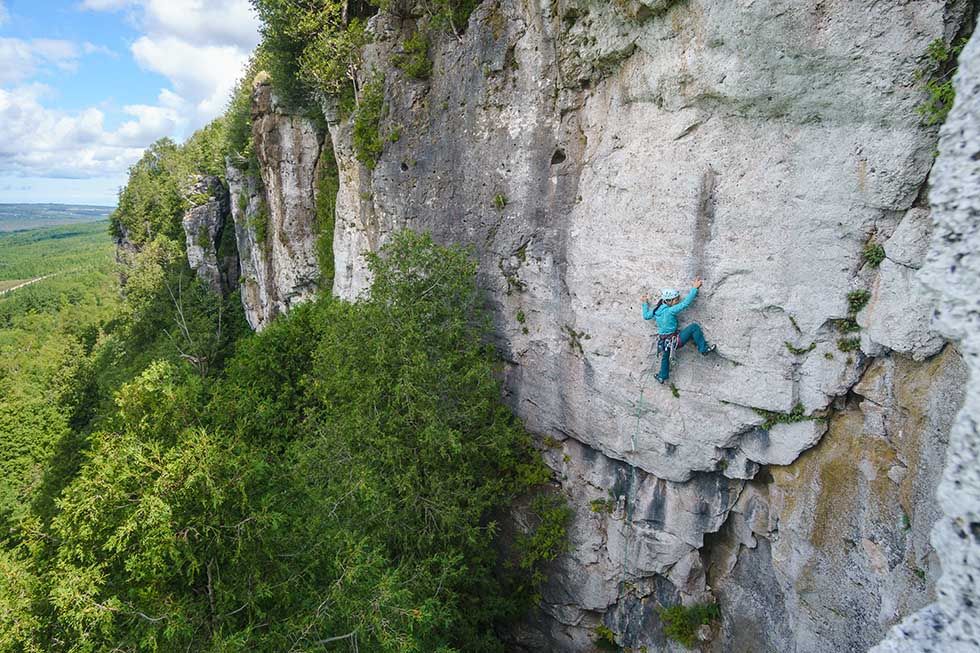
Old Baldy, Kimberley
Situated up high in the Beaver Valley, Old Baldy is a limestone outcrop that overlooks the small village of Kimberley. The west-facing crag receives plenty of afternoon sun and is a great spot for watching sunsets. Due to the porous nature of the rock and the exposed position within the valley, Old Baldy dries quickly after a rainstorm. Climbers will find vertical, pocketed routes with plenty of texture on the rock from embedded crystals and fossils. This crag is excellent for those who climb in the moderate to difficult range with many classic routes like Tiny Bubbles, Bear on a Wire, French Revolution and Christina’s World. Below the cliff top, Kimberley is the perfect refueling stop. The Kimberley General Store has freshly baked goods and treats to power your day while Justin’s Oven and Heart’s have delicious gourmet food after a day of climbing. Old Baldy is also a success story in the Ontario climbing community—in 2013 the land adjacent to Old Baldy was listed for sale, so the OAC applied for, and received a land grant from Mountain Equipment Company and with combined donations (from the Bruce Trail Conservancy, Grey Sauble Conservation Authority, Alpine Club of Canada, the Nature League, and climbers in the community) were able to purchase the land. This purchase has secured climbing access at the crag and is a shining example of how the OAC and the community can come together to preserve climbing access in this province.
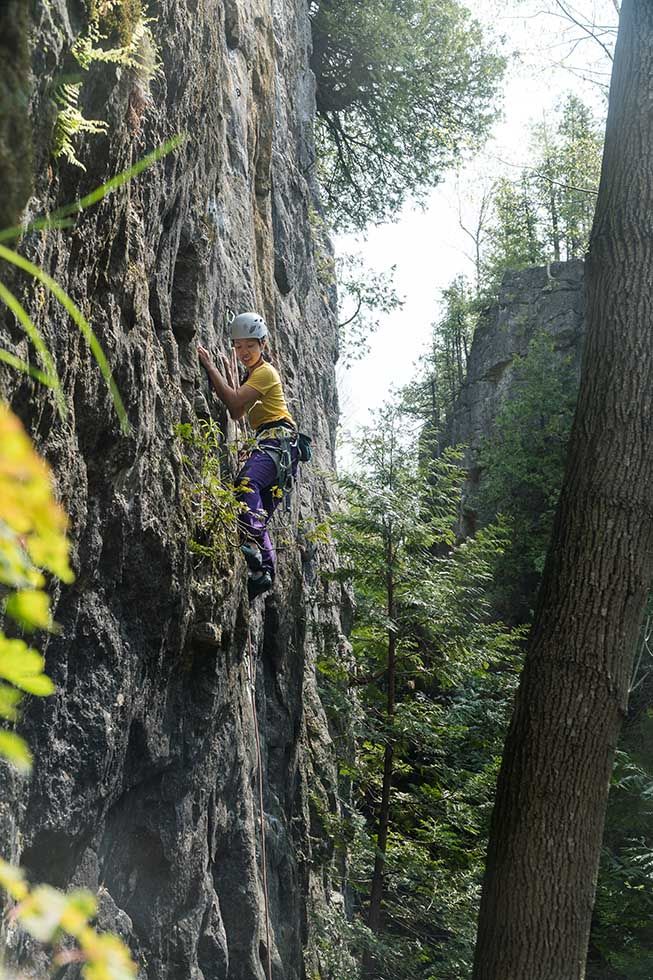
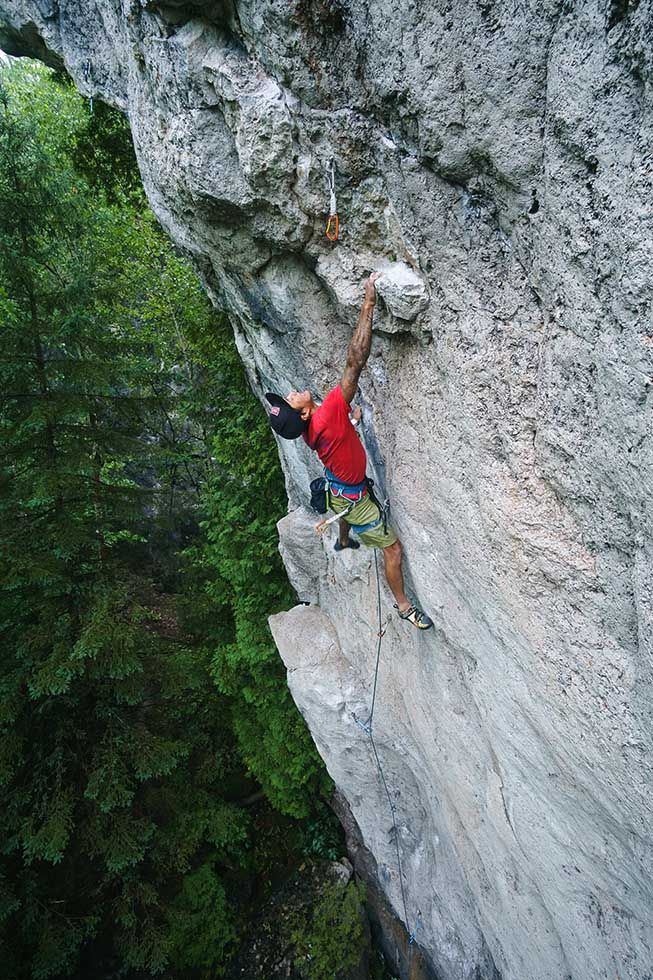
The Swamp/Kolapore Uplands, Grey County
The Swamp is a crag tucked away in the forest of Kolapore Uplands. There are over 100 climbing routes that cater to climbers of all abilities. The routes are slightly shorter here, which may play in favour for newer climbers. Climbing bolts, which are used to protect the climbers from hitting the ground in the case of a fall, are placed closer together at The Swamp which could help gym climbers’ transition to outdoor rock climbing more easily. Although the cliff faces south, climbers can still chase shade in the summer by climbing routes in the numerous gullies and rock outcrops. Standout routes include Gerry Gerbils, Sausage Factory, Stainless Stihl, and The Lucifer Effect. This beloved crag was also the venue for some of the climbing clinics during the 2017-19 Beaver Valley Climbing Festivals. Post-climbing après are plentiful in the nearby town of Collingwood, which is also a convenient home base to stay for those looking for modern amenities.
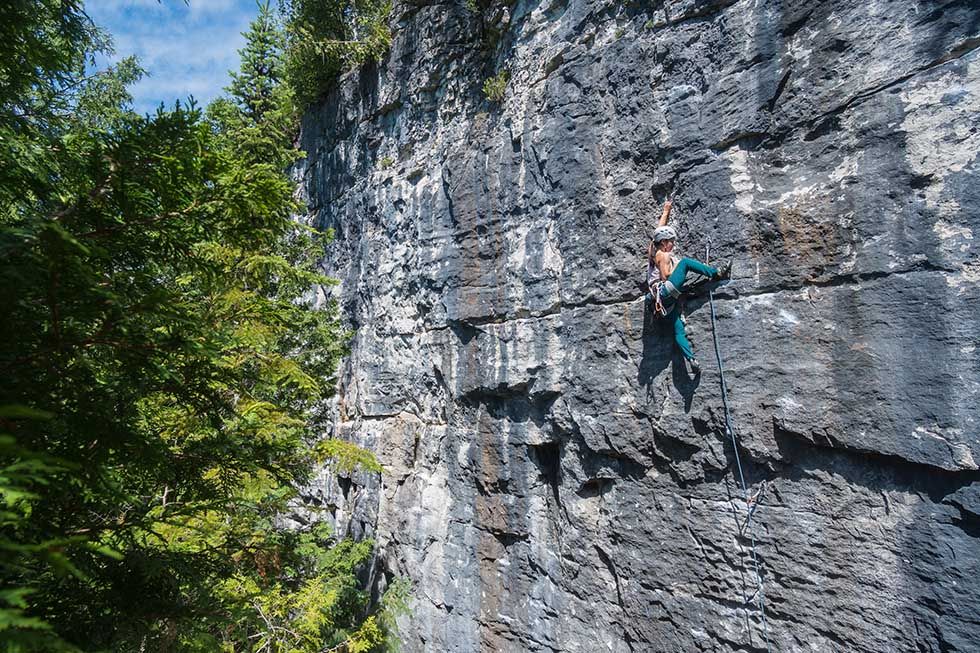
Devil’s Glen, Simcoe County
Devil’s Glen is another crag perfect for climbers of all abilities and styles—the routes range from beginner friendly to very difficult in both sport and traditional styles of climbing. While bolted sport climbing routes focus on athletic movement over clean rock faces, traditional climbing follows fissures and cracks in the rock in which the climber places their own protection. Arguably the best traditional route in the province for its grade is here; Nutcracker is a clean open-book crack in the middle of the crag. Beginner climbers will have fun on routes like Mellicious, Morning Star, and Sun Worshipper, while those looking for more difficult climbs will enjoy Mystery of a Lost History and Legends of the Fall. Climbing at Devil’s Glen has been a favourite among climbers for almost half a century due to its unique technical style of climbing. Unlike many of the crags mentioned above, Devil’s Glen climbing tends to have smaller hand and foot holds forcing climbers to perform a delicate dance as they work their way up the wall. Although in many ways, this can be more challenging, gaining climbing skills at Devil’s Glen allow you to take those skills and apply them almost anywhere else. On hot summer days, the cool gullies provide relief and a short trek to the Mad River is a must for a refreshing swim. Stay for dinner at Mylar & Loreta’s Restaurant in Singhampton, the small-town charm will have you returning for future climbing trips to Devil’s Glen.
The four crags above only represent a handful of the amazing climbing we’re so lucky to have access to along the Niagara Escarpment. Although rock climbers are just one user group of the Escarpment, we must not take the natural beauty for granted. Nature is sensitive and we all must preserve what we can as outdoor enthusiasts and recreationalists. When you venture out this summer for rock climbing, leave the crag better than when you found it by packing out trash and following leave-no-trace practices. Consider supporting the local economy in the areas you climb in by stopping in for a meal or picking up a snack. For first-time outdoor rock climbers, search for a local guiding company that can safely provide a memorable experience. And lastly, consider joining the Ontario Alliance of Climbers, a non-profit volunteer organization dedicated to keeping climbing areas open. Climb on!
